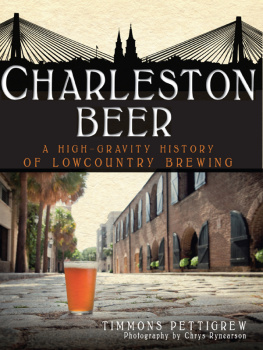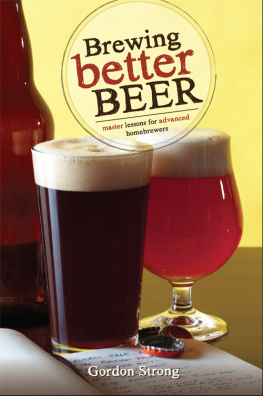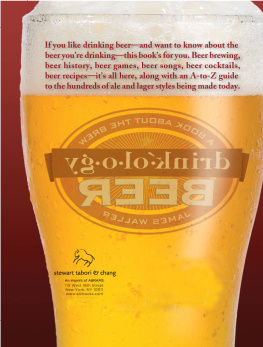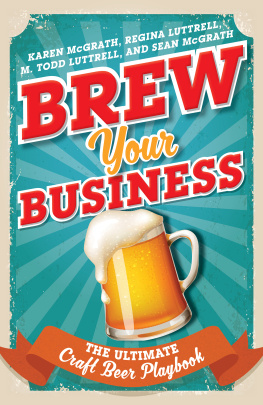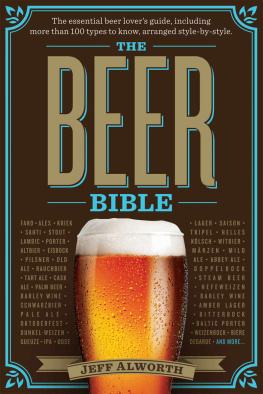Contents
Guide
THE ENCYCLOPEDIA OF BEER
Christine P. Rhodes, General Editor
Pamela B. Lappies, Project Editor
Contributing Editors:
Thomas Bedell, Alan Eames, Fred Eckhardt, Robert Haiber,
Karl F. Lutzen, Alan John Pugsley, Peter V. K. Reid,
Christine P. Rhodes, and Mark Stevens
A Henry Holt Reference Book
Henry Holt and Company
New York
The author and publisher have provided this e-book to you for your personal use only. You may not make this e-book publicly available in any way. Copyright infringement is against the law. If you believe the copy of this e-book you are reading infringes on the authors copyright, please notify the publisher at: http://us.macmillanusa.com/piracy.
CONTRIBUTING EDITOR PROFILES
THOMAS BEDELL is an author, freelance writer, and editor. His work has appeared in dozens of general interest and specialty publications, including Beer: the magazine and All About Beer. An award-winning homebrewer, Bedell is also a certified beer judge. He lives in Williamsville, Vermont.
ALAN D. EAMES is a beer consultant, historian, and writer. He is a regular contributor to such beer periodicals as All About Beer and Beer: the magazine and the author of Secret Life of Beer, A Beer Drinkers Companion and the Oldenberg Beer Drinkers Bible. Eames is a founding director of the American Museum of Brewing History & Fine Arts in Fort Mitchell, Kentucky, and established the $3 Deweys Ale House in Portland, Maine. He lives in Brattleboro, Vermont.
FRED ECKHARDT is a writer and publisher who has specialized in sake, beer, and brewing-related subjects for more than a quarter century. A contributor to and regular columnist for All About Beer, Celebrator Beer News, and Southern Draft Beer News, Eckhardt also contributes to American Brewer, Zymurgy, The New Brewer, and other periodicals. He is the author of A Treatise on Lager Beer, Essentials of Beer Style, and Sake (U.S.A.). Eckhardt lives in Portland, Oregon.
ROBERT HAIBER, a freelance writer specializing in beer history, is an internationally recognized beer expert and certified beer judge. He is the founder of the North American Guild of Beer Writers and coauthor of the book A Short but Foamy History of Beer. Haiber lives in La Grangeville, New York.
KARL F. LUTZEN is the coauthor of Homebrew Favorites: A Coast-to-Coast Collection of More Than 240 Beer and Ale Recipes. He is also co-editor of the computer-accessible public domain beer recipe books Cats Meow and Cats Meow 2. Lutzen lives in Rolla, Missouri.
ALAN JOHN PUGSLEY has a degree in biochemistry from Manchester University. A brewmaster, he is President and majority owner of Peter Austin & Partners (Contracts), Ltd., a company headquartered in Portland, Maine, that designs and installs microbreweries and pub breweries worldwide. Pugsley is also a part owner of Kennebunkport Brewing Co./Shipyard Brewer in Portland, where he lives.
PETER V. K. REID is the editor of Modern Brewery Age. He frequently writes about beer, and his work includes extensive reporting on the evolution of the brewing industry. A graduate of Hobart College, Reid lives in Weston, Connecticut.
CHRISTINE P. RHODES, who has served as editor as well as advertising and marketing director of Modern Brewery Age, is a freelance writer and editor whose specialty is beer and brewing. She lives in Providence, Rhode Island.
MARK STEVENS is the coauthor of Homebrew Favorites: A Coast-to-Coast Collection of More Than 240 Beer and Ale Recipes. Stevens has written for All About Beer magazine and he co-edited the computer-accessible public-domain beer recipe books Cats Meow and Cats Meow 2 Stevens lives in Beltsville, Maryland.
INTRODUCTION
BEER: A JOURNEY
T he art of brewing is thousands of years old. Through hieroglyphics, cuneiform characters, and artifacts, beer historians have traced the roots of brewing back to the women of ancient African, Egyptian, and Sumerian tribes some 8,000 years ago. Things in the beer world have changed quite a bit since 6000 B.C. , and today we find ourselves in the midst of an exciting and ever-changing industry that supports over 600 breweries in the United States alone. Despite the growth of the industry particularly that of the microbrewing, brewpub, homebrewing, specialty beer, and import segments there has not until now been a compendium of information available. It is our hope that The Encyclopedia of Beer will clarify every question you ever had about beer but were afraid to ask. From Abbaye to Alken Maes, hops to hefe-weizen, original gravity to Oktoberfest, and zwickel cock to Zythos and everything in between we hope to help you on your journey to discover all you ever wanted to know about beer and brewing.
To help you use this book, you need to know how beer is classified and it is classified in a variety of ways. The color, alcohol content, amount of fermentables, style, type of ferment, and season may all be used to differentiate various beers. Most beer merchants identify each beer by the country in which it was produced. This classification is less than satisfactory, as most countries produce beers that are similar to those in other countries. For instance, many Norwegian, Swiss, and even Thai beers are very similar in style, content, color, and method of ferment to German, Czech Republic, and Dutch beers. Australians, Japanese, Canadians, and Mexicans make beers that are virtually indistinguishable from those made in the United States. Fiji, Nigeria, Hong Kong, and Singapore produce beers quite similar to those made in Great Britain. Belgium produces very distinctive beers, but even its beers are beginning to be copied in the United States, mostly by microbrewers and specialty brewers. Many Americans try to distinguish beer based on whether it is pale or dark in color. Others look for ales or lagers, which are also known as warm- or cold-fermented beers.
The classification system used in this book is based broadly on the system devised by beer critic and writer Michael Jackson. He has identified approximately 41 different beer styles, and his work has been expanded upon, first by Fred Eckhardt in Essentials of Beer Styles and then by Charlie Papazian in the style guidelines for the Great American Beer Festival.
As is true with any classification system, there are arbitrary distinctions in this book, especially where the styles blend into one another. There is always the classic argument about when an ale is truly an ale. The purist would say that an ale is a top-fermented beer, but that is an oversimplification. The United States brewing industry says that an ale is a beer that is warm-fermented (above 60F, or 15.5C) during part of the ferment, no matter what type of yeast is used. This books classification system allows for both possibilities. Some Belgian Trappist beers are produced from three ferments, using three yeasts, and perhaps three different temperatures. There is more to beer than yeast a lot more to the world of beer than most people ever imagined.
When we talk about beer in this book, there are several points of reference. Original gravity, alcohol content, bitterness units, color, type of fermentation, and aging are among these points.



